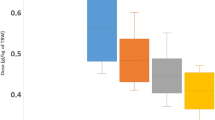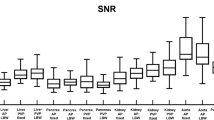Abstract
Objective
To determine a personalized and optimized contrast injection protocol for a uniform and optimal diagnostic level of liver parenchymal enhancement, in a large patient population enrolled in a multicenter study.
Methods
Six hundred ninety-two patients who underwent a standardized multi-phase liver CT examination were prospectively assigned to one contrast media (CM) protocol group: G1 (100 mL fixed volume, 37 gI); G2 (600 mgI/kg of total body weight (TBW)); G3 (750 mgI/kg of fat-free mass (FFM)), and G4 (600 mgI/kg of FFM). Change in liver parenchyma CT number between unenhanced and contrast-enhanced images was measured by two radiologists, on 3-mm pre-contrast and portal phase axial reconstructions. The enhancement histograms were compared across CM protocols, specifically according to a target diagnostic value of 50 HU. The total amount of iodine dose was also compared among protocols by median and interquartile range (IQR). The Kruskal-Wallis and Mann-Whitney U tests were used to assess significant differences (p < 0.005), as appropriate.
Results
A significant difference (p < 0.001) was found across the groups with liver enhancement decreasing from median over-enhanced values of 77.0 (G1), 71.3 (G2), and 65.1 (G3) to a target enhancement of 53.2 HU for G4. Enhancement IQR was progressively reduced from 26.5 HU (G1), 26.0 HU (G2), and 17.8 HU (G3) to 14.5 HU (G4). G4 showed a median iodine dose of 26.0 gI, significantly lower (p < 0.001) than G3 (33.9 gI), G2 (38.8 gI), and G1 (37 gI).
Conclusions
The 600 mgI/kg FFM-based protocol enabled a diagnostically optimized liver enhancement and improved patient-to-patient enhancement uniformity, while significantly reducing iodine load.
Key Points
• Consistent and clinically adequate liver enhancement is observed with personalized and optimized contrast injection protocol.
• Fat-free mass is an appropriate body size parameter for correlation with liver parenchymal enhancement.
• Diagnostic oncology follow-up liver CT examinations may be obtained using 600 mgI/kg of FFM.






Similar content being viewed by others
Abbreviations
- BMI:
-
Body mass index
- CM:
-
Contrast media
- CT:
-
Computed tomography
- FFM:
-
Fat-free mass
- MDCT:
-
Multidetector CT scanner
- TBW:
-
Total body weight
References
Hollett MD, Jeffrey RB, Nino-Murcia M et al (1995) Dual-phase helical CT of the liver: value of arterial phase scans in the detection of small (< or = 1.5 cm) malignant hepatic neoplasms. AJR Am J Roentgenol 164(4):879–884. https://doi.org/10.2214/ajr.164.4.7726040
Bae KT (2010) Intravenous contrast medium administration and scan timing at CT: considerations and approaches. Radiology 256(1):32–61. https://doi.org/10.1148/radiol.10090908
Walgraeve M-S, Pyfferoen L, Van De Moortele K et al (2019) Implementation of patient-tailored contrast volumes based on body surface area and heart rate harmonizes contrast enhancement and reduces contrast load in small patients in portal venous phase abdominal CT. Eur J Radiol 121:108630. https://doi.org/10.1016/j.ejrad.2019.07.031
Awai K, Kanematsu M, Kim T et al (2016) The optimal body size index with which to determine iodine dose for hepatic dynamic CT: a prospective multicenter study. Radiology. 278:773–781. https://doi.org/10.1148/radiol.2015142941
Benbow M, Bull RK (2011) Simple weight-based contrast dosing for standardization of portal phase CT liver enhancement. Clin Radiol 66(10):940–944. https://doi.org/10.1016/j.crad.2010.12.022
Botsikas D, Barnaure I, Terraz S et al (2016) Value of liver computed tomography with iodixanol 270, 80 kVp and iterative reconstruction. World J Radiol 8(7):693–699. https://doi.org/10.4329/wjr.v8.i7.693
Caruso D, De Santis D, Rivosecchi F et al (2018) Lean body weight-tailored iodinated contrast injection in obese patient: Boer versus James formula. Biomed Res Int 2018:8521893. https://doi.org/10.1155/2018/8521893
Feng S-T, Zhu H, Peng Z et al (2017) An individually optimized protocol of contrast medium injection in enhanced CT scan for liver imaging. Contrast Media Mol Imaging 2017:7350429. https://doi.org/10.1155/2017/7350429
Fleischmann D, Kamaya A (2009) Optimal vascular and parenchymal contrast enhancement: the current state of the art. Radiol Clin North Am 47(1):13–26. https://doi.org/10.1016/j.rcl.2008.10.009
Goshima S, Kanematsu M, Noda Y et al (2016) Minimally required iodine dose for the detection of hypervascular hepatocellular carcinoma on 80-kVp CT. AJR Am J Roentgenol 206(3):518–525. https://doi.org/10.2214/AJR.15.15138
Ho LM, Nelson RC, DeLong DM (2007) Determining contrast medium dose and rate on basis of lean body weight: does this strategy improve patient-to-patient uniformity of hepatic enhancement during multi–detector row CT? Radiology. 243(2):431–437. https://doi.org/10.1148/radiol.2432060390
Ichikawa T, Erturk SM, Araki T (2006) Multiphasic contrast-enhanced multidetector-row CT of liver: contrast-enhancement theory and practical scan protocol with a combination of fixed injection duration and patients’ body-weight-tailored dose of contrast material. Eur J Radiol 58(2):165–176. https://doi.org/10.1016/j.ejrad.2005.11.037
Jo BG, Song YG, Shim SG, Kim YW (2016) Comparison of enhancement and image quality: different iodine concentrations for liver on 128-slice multidetector computed tomography in the same chronic liver disease patients. Korean J Intern Med 31(3):461–469. https://doi.org/10.3904/kjim.2014.210
Koiwahara G, Tsuda T, Matsuda M et al (2015) Different enhancement of the hepatic parenchyma in dynamic CT for patients with normal liver and chronic liver diseases and with the dose of contrast medium based on body surface area. Jpn J Radiol 33(4):194–200. https://doi.org/10.1007/s11604-015-0398-1
Kondo H, Kanematsu M, Goshima S et al (2010) Body size indexes for optimizing iodine dose for aortic and hepatic enhancement at multidetector CT: comparison of total body weight, lean body weight, and blood volume. Radiology 254(1):163–169. https://doi.org/10.1148/radiol.09090369
Masuda T, Nakaura T, Funama Y et al (2017) Aortic and hepatic contrast enhancement during hepatic-arterial and portal venous phase computed tomography scanning: multivariate linear regression analysis using age, sex, total body weight, height, and cardiac output. J Comput Assist Tomogr 41(2):309–314. https://doi.org/10.1097/RCT.0000000000000513
Peet K, Clarke SE, Costa AF (2019) Hepatic enhancement differences when dosing iodinated contrast media according to total versus lean body weight. Acta Radiol 60(7):807–814. https://doi.org/10.1177/0284185118801137
Zanardo M, Doniselli FM, Esseridou A et al (2018) Abdominal CT: a radiologist-driven adjustment of the dose of iodinated contrast agent approaches a calculation per lean body weight. Eur Radiol Exp 2(1):41. https://doi.org/10.1186/s41747-018-0074-1
Zhang X, Li S, Liu W et al (2016) Double-low protocol for hepatic dynamic CT scan: effect of low tube voltage and low-dose iodine contrast agent on image quality. Medicine (Baltimore) 95(26):e4004. https://doi.org/10.1097/MD.0000000000004004
Funama Y, Awai K, Nakayama Y et al (2005) Radiation dose reduction without degradation of low-contrast detectability at abdominal multisection CT with a low–tube voltage technique: phantom study. Radiology. 237(3):905–910. https://doi.org/10.1148/radiol.2373041643
Hamer OW, Aguirre DA, Casola G et al (2006) Fatty liver: imaging patterns and pitfalls. Radiographics 26(6):1637–1653. https://doi.org/10.1148/rg.266065004
Gupta AA, Kim DC, Krinsky GA et al (2004) CT and MRI of cirrhosis and its mimics. AJR Am J Roentgenol 183(6):1595–1601. https://doi.org/10.2214/ajr.183.6.01831595
Li S, Sun X, Chen M et al (2019) Liver fibrosis conventional and molecular imaging diagnosis update. J Liver 8(1):236
Bell H, Rostad B, Raknerud N, Try K (1994) Computer tomography in the detection of hemochromatosis. Tidsskr Nor Laegeforen 114:1697–1699
Brat H, Zanca F, Montandon S et al (2019) Local clinical diagnostic reference levels for chest and abdomen CT examinations in adults as a function of body mass index and clinical indication: a prospective multicenter study. Eur Radiol 29(12):6794–6804. https://doi.org/10.1007/s00330-019-06257-x
Weininger M, Barraza JM, Kemper CA et al (2011) Cardiothoracic CT angiography: current contrast medium delivery strategies. AJR Am J Roentgenol 196(3):W260–WW72. https://doi.org/10.2214/AJR.10.5814
Li C, Ford ES, Zhao G et al (2009) Estimates of body composition with dual-energy X-ray absorptiometry in adults. Am J Clin Nutr 90(6):1457–1465. https://doi.org/10.3945/ajcn.2009.28141
Kidoh M, Nakaura T, Oda S et al (2013) Contrast enhancement during hepatic computed tomography: effect of total body weight, height, body mass index, blood volume, lean body weight, and body surface area. J Comput Assist Tomogr 37(2):159–164. https://doi.org/10.1097/RCT.0b013e31827dbc08
Costa AF, Peet K, Abdolell M (2020) Dosing iodinated contrast media according to lean versus total body weight at abdominal CT: a stratified randomized controlled trial. Acad Radiol 27(6):833–840. https://doi.org/10.1016/j.acra.2019.07.014
Rengo M, Bellini D, Businaro R et al (2017) MDCT of the liver in obese patients: evaluation of a different method to optimize iodine dose. Abdom Radiol (NY) 42(10):2420–2427. https://doi.org/10.1007/s00261-017-1156-x
Kondo H, Kanematsu M, Goshima S et al (2011) Aortic and hepatic enhancement at multidetector CT: evaluation of optimal iodine dose determined by lean body weight. Eur J Radiol 80(3):e273–e277. https://doi.org/10.1016/j.ejrad.2010.12.009
Kondo H, Kanematsu M, Goshima S et al (2013) Body size indices to determine iodine mass with contrast-enhanced multi-detector computed tomography of the upper abdomen: does body surface area outperform total body weight or lean body weight? Eur Radiol 23(7):1855–1861. https://doi.org/10.1007/s00330-013-2808-z
Matsumoto Y, Masuda T, Sato T et al (2019) Contrast material injection protocol with the dose determined according to lean body weight at hepatic dynamic computed tomography: comparison among patients with different body mass indices. J Comput Assist Tomogr 43(5):736–740. https://doi.org/10.1097/RCT.0000000000000909
Nyman U (2016) James lean body weight formula is not appropriate for determining CT contrast media dose in patients with high body mass index. Radiology 278(3):956–957. https://doi.org/10.1148/radiol.2016152031
Jensen B, Braun W, Geisler C et al (2019) Limitations of fat-free mass for the assessment of muscle mass in obesity. Obes Facts 12(3):307–315. https://doi.org/10.1159/000499607
Funding
The authors state that this work has not received any funding.
Author information
Authors and Affiliations
Corresponding author
Ethics declarations
Guarantor
The scientific guarantor of this publication is Federica Zanca.
Conflict of interest
The authors of this manuscript declare relationships with the following companies:
P Pujadas is an employee of GE Healthcare.
Statistics and biometry
No complex statistical methods were necessary for this paper.
Informed consent
A written informed consent is submitted to every patient upon admission in Groupe 3r stating, among others, possible use of anonymized patient data for research purposes. The patient is free to oppose this use and listed as such. Specific written informed consent was therefore waived by the Institutional Review Board.
Ethical approval
Institutional Review Board approval was obtained.
Methodology
• prospective
• experimental
• multicenter study.
Additional information
Publisher’s note
Springer Nature remains neutral with regard to jurisdictional claims in published maps and institutional affiliations.
Rights and permissions
About this article
Cite this article
Zanca, F., Brat, H.G., Pujadas, P. et al. Prospective multicenter study on personalized and optimized MDCT contrast protocols: results on liver enhancement. Eur Radiol 31, 8236–8245 (2021). https://doi.org/10.1007/s00330-021-07953-3
Received:
Revised:
Accepted:
Published:
Issue Date:
DOI: https://doi.org/10.1007/s00330-021-07953-3




